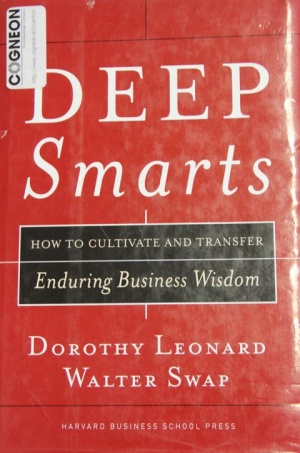Deep smarts: how to cultivate and transfer enduring business wisdom: Unterschied zwischen den Versionen
K.kley (Diskussion | Beiträge) |
K.kley (Diskussion | Beiträge) Keine Bearbeitungszusammenfassung |
||
| Zeile 1: | Zeile 1: | ||
{{Piktogramm_buch}} | {{Piktogramm_buch}} | ||
[[Bild:Deep_Smarts.jpg|thumb]] | |||
In '''Deep Smarts''', Dorothy Leonard and Walter Swap provide penetrating insight into the relationships among knowledge, competitive advantage, and continuous innovation. What sets deep smarts apart and makes them so competitively valuable is that they are built on firsthand life experiences, resulting in tacit knowledge that is hard for other firms to copy. But this transfer barrier is precisely what makes deep smarts such a challange to manage inside organizations. | In '''Deep Smarts''', Dorothy Leonard and Walter Swap provide penetrating insight into the relationships among knowledge, competitive advantage, and continuous innovation. What sets deep smarts apart and makes them so competitively valuable is that they are built on firsthand life experiences, resulting in tacit knowledge that is hard for other firms to copy. But this transfer barrier is precisely what makes deep smarts such a challange to manage inside organizations. | ||
| Zeile 6: | Zeile 7: | ||
* Determine where "knowledge gaps" exist and how to fill them | * Determine where "knowledge gaps" exist and how to fill them | ||
* Create an environment that encourages experience-based learning<ref>Leonard, D.; Swap, W.: Deep Smarts: How to Cultivate and Transfer Enduring Business Wisdom</ref> | * Create an environment that encourages experience-based learning<ref>Leonard, D.; Swap, W.: Deep Smarts: How to Cultivate and Transfer Enduring Business Wisdom</ref> | ||
==Weblinks== | ==Weblinks== | ||
Version vom 22. März 2013, 11:11 Uhr
In Deep Smarts, Dorothy Leonard and Walter Swap provide penetrating insight into the relationships among knowledge, competitive advantage, and continuous innovation. What sets deep smarts apart and makes them so competitively valuable is that they are built on firsthand life experiences, resulting in tacit knowledge that is hard for other firms to copy. But this transfer barrier is precisely what makes deep smarts such a challange to manage inside organizations. Based on a mulityear research project observing and interviewing coaches and protégés in start-ups and mature firms, this book reveals how deep smarts can be cultivated and leveraged across the entire company. The authors show that deep smarts derive from the development of "experience repertoires" guided by knowledge coaches. Using vivid examples from their study, Leonard and Swap explore how managers can:
- Identify wich individuals possess deep smarts
- Determine where "knowledge gaps" exist and how to fill them
- Create an environment that encourages experience-based learning[1]
Weblinks
- Deep smarts: how to cultivate and transfer enduring business wisdom bei Google Buchsuche
- Deep smarts: how to cultivate and transfer enduring business wisdom bei Amazon Search Inside
- Deep smarts: how to cultivate and transfer enduring business wisdom Buchkritik bei Barnes&Noble
Einzelnachweise
- ↑ Leonard, D.; Swap, W.: Deep Smarts: How to Cultivate and Transfer Enduring Business Wisdom
